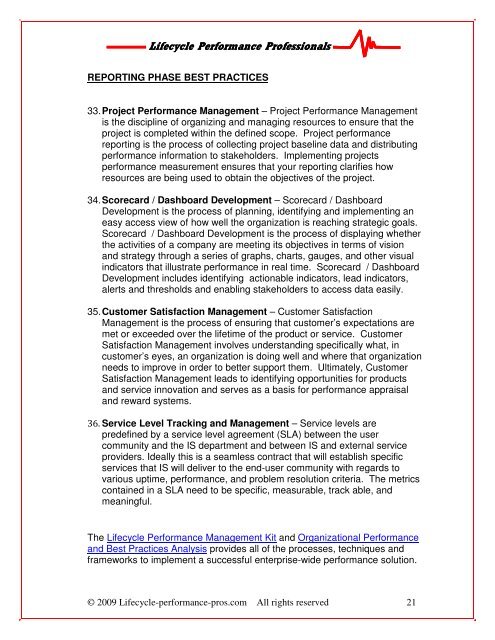Download the Performance Management Fundamentals Guide
Download the Performance Management Fundamentals Guide
Download the Performance Management Fundamentals Guide
Create successful ePaper yourself
Turn your PDF publications into a flip-book with our unique Google optimized e-Paper software.
Lifecycle Lifecycle <strong>Performance</strong> <strong>Performance</strong> Professionals<br />
Professionals<br />
REPORTING PHASE BEST PRACTICES<br />
33. Project <strong>Performance</strong> <strong>Management</strong> – Project <strong>Performance</strong> <strong>Management</strong><br />
is <strong>the</strong> discipline of organizing and managing resources to ensure that <strong>the</strong><br />
project is completed within <strong>the</strong> defined scope. Project performance<br />
reporting is <strong>the</strong> process of collecting project baseline data and distributing<br />
performance information to stakeholders. Implementing projects<br />
performance measurement ensures that your reporting clarifies how<br />
resources are being used to obtain <strong>the</strong> objectives of <strong>the</strong> project.<br />
34. Scorecard / Dashboard Development – Scorecard / Dashboard<br />
Development is <strong>the</strong> process of planning, identifying and implementing an<br />
easy access view of how well <strong>the</strong> organization is reaching strategic goals.<br />
Scorecard / Dashboard Development is <strong>the</strong> process of displaying whe<strong>the</strong>r<br />
<strong>the</strong> activities of a company are meeting its objectives in terms of vision<br />
and strategy through a series of graphs, charts, gauges, and o<strong>the</strong>r visual<br />
indicators that illustrate performance in real time. Scorecard / Dashboard<br />
Development includes identifying actionable indicators, lead indicators,<br />
alerts and thresholds and enabling stakeholders to access data easily.<br />
35. Customer Satisfaction <strong>Management</strong> – Customer Satisfaction<br />
<strong>Management</strong> is <strong>the</strong> process of ensuring that customer’s expectations are<br />
met or exceeded over <strong>the</strong> lifetime of <strong>the</strong> product or service. Customer<br />
Satisfaction <strong>Management</strong> involves understanding specifically what, in<br />
customer’s eyes, an organization is doing well and where that organization<br />
needs to improve in order to better support <strong>the</strong>m. Ultimately, Customer<br />
Satisfaction <strong>Management</strong> leads to identifying opportunities for products<br />
and service innovation and serves as a basis for performance appraisal<br />
and reward systems.<br />
36. Service Level Tracking and <strong>Management</strong> – Service levels are<br />
predefined by a service level agreement (SLA) between <strong>the</strong> user<br />
community and <strong>the</strong> IS department and between IS and external service<br />
providers. Ideally this is a seamless contract that will establish specific<br />
services that IS will deliver to <strong>the</strong> end-user community with regards to<br />
various uptime, performance, and problem resolution criteria. The metrics<br />
contained in a SLA need to be specific, measurable, track able, and<br />
meaningful.<br />
The Lifecycle <strong>Performance</strong> <strong>Management</strong> Kit and Organizational <strong>Performance</strong><br />
and Best Practices Analysis provides all of <strong>the</strong> processes, techniques and<br />
frameworks to implement a successful enterprise-wide performance solution.<br />
© 2009 Lifecycle-performance-pros.com All rights reserved 21










